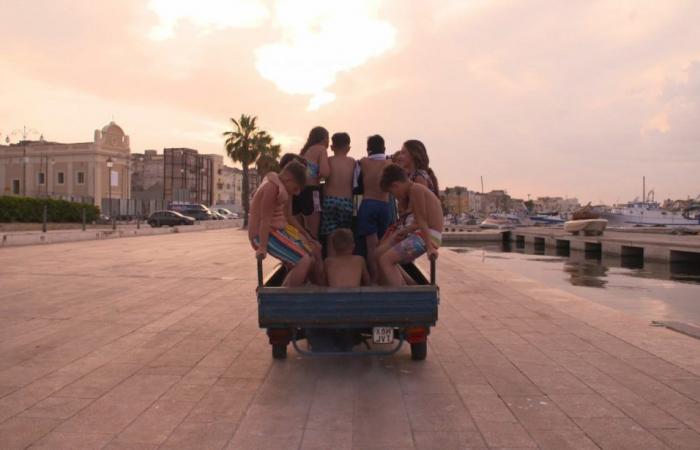The sound of hooves. As evening falls, a horse approaches a large tub to drink. All around, silence, countryside. In the background, the immense Ilva steelworks in Taranto, very recognizable. From the very first frames, Bangarang, Giulio Mastromauro’s first documentary, expands the viewer’s gaze, leading him on a journey into the beauty and oxymorons of a violated land, through the lives of its young inhabitants, a gang of sweet and wild kids who in some ways already seem like adults. The white alleys of the old city, the deserted squares and the tenements of the dormitory neighborhoods devoured by the rust of the steelworks, the dives from fishing boats into the port. The faces, the voices, free bodies exploring. Nominated as best documentary at the Nastri d’Argento and the Globo D’Oro, Bangarang is among the works selected by the Ischia Film Festival, a historic festival directed by Michelangelo Messina in its twenty-second edition (June 29 – July 6 at the Aragonese Castle), which explores Italian and international auteur cinema with a very wide selection of feature films, documentaries, previews and international guests. The works chosen this year revolve around ethical, political and social themes in symbolic landscapes that tell the relationship between territory and cinema, the “genius loci” where stories are born. Mastromauro, with several short films under his belt, including Winter with Mimmo Cuticchio (best documentary at the David di Donatello 2022), will meet the public to present the film tonight at the Casa del Sole at 9 pm.
How did this documentary come about?
I was in Taranto for location scouting for a film in progress, I was struck by the city and the people, the spark was lit, the desire to tell it from the point of view of nature and the children who live there. At the beginning I wanted to exclude the Ilva theme, to focus on the childhood of an industrial suburb of a city in the south. As the weeks went by I realized that the theme was very sensitive: Taranto is divided between those who fight and those who continue to defend the presence of the steelworks. I didn’t want to make an investigative film but to put the viewer in front of a scenario, to throw a seed. Those who watch can make it germinate, give it a follow-up, going to document themselves on a very complex reality that is not told by the media.
How did he relate to the city and the places?
I started with some local associations that perhaps understood the honesty with which I was trying to tell Taranto. I talked to people. Everyone is dying, the houses, especially in some areas like the Tamburi neighborhood, near the Ilva, have lost market value, many families still have mortgages to pay. Suddenly I came across the Teatro Crest, a hub of enlightened people who work in Tamburi. Giovanni Guarino opened up a world to me, creating connections in the various neighborhoods. I met kids, many with complicated family situations. I started following them. I focused on those who seemed most vital to me and represented a certain type of childhood. They come from different areas: the old city, Tamburi, the Tramontone neighborhood where there is the mural by Giorgio Di Ponzio, who died of cancer at 15, Salinella, Paolo Sesto, Mar Piccolo where children go to dive into the Taras river from which the city takes its name. Only the new city is missing, separated from the rest by a stone bridge. Those who live there think they are safe from everything.
How did you work with the kids?
They are the ones who built the film. They took me by the hand, they took me to places I would never have discovered. I remember the day we arrived at the wind farm at sea, recently installed. I found this group of kids without adults who had their secret place to swim. It was a constant amazement. At the beginning I let them touch the camera, I put them at ease: not judging them, putting myself at their level. It would have been impossible to cage them, they were so wild, so free in their living of the space. Even making an appointment was unthinkable. The process was complex, we had to constantly ride the unexpected: it is a film of instinct. Every time there was a situation that had the potential to become a scene, we composed the image and left them free.
The steel mill suddenly seems to become one of the protagonists of the documentary, together with the children and the animals – dolphins, flamingos, horses, snails.
Whatever my point of observation of these children in the city, the factory, with its chimneys, was always in the background. There is the sea, the sky and then there is the steelworks, which I believe is two, three times bigger than Taranto itself. It was impossible to exclude it. Its constant presence contrasts with the total unawareness of the children and the beauty of nature. The sheep and horses are from Vincenzo Fornaro’s Masseria which is located opposite the Ilva: he was forced to slaughter more than three hundred heads of sheep due to the presence of dioxin. He has transformed the company into a riding school, he raises silkworms. The chimneys are one with the city, they seem to sprout from the buildings.
Why «bangarang»?
In this film there are no adults, I made this decision at the beginning and I followed it through to the end. Reality seen only through the eyes of children recalls Neverland, Peter Pan. In Spielberg’s film the pirate children shout “bangarang!”. This is a work about resistance: the resistance of the new generations and the resistance of nature that (re)takes its space, despite everything.



